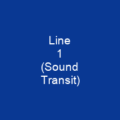The Downtown Seattle Transit Tunnel: A Journey Through Time
Imagine stepping into the heart of downtown Seattle, where history meets modernity in an underground marvel known as the Downtown Seattle Transit Tunnel (DSTT). This 1.3-mile-long tunnel has been a cornerstone of transit innovation since its inception, serving not just buses but also light rail trains on the 1 Line.
From Buses to Trains: A Shared Journey
The DSTT was initially built for buses in 1990. But as Seattle’s transportation needs evolved, so did the tunnel. In 2005, it began sharing space with light rail trains, making it one of only two tunnels in the United States to do so. This shared journey between buses and trains is a testament to the city’s commitment to sustainable transit solutions.
Artwork and Accessibility
The tunnel isn’t just about transportation; it’s also an art gallery. Commissioned by King County Metro, 25 artists have contributed artwork valued at $1.5 million, making each station a unique experience for riders. The artwork adds a layer of cultural richness to the journey underground.
Station Life: A Hub of Activity
The DSTT has four stations, each serving as a gateway to different parts of Seattle. Westlake Station is known as the Westlake Hub, connecting various transit systems and retail outlets. Symphony Station features a split mezzanine with entrances to 2nd Avenue and University Street from one side and Seneca Street from the other.
Historic Pioneer Square
Pioneer Square station, located between Cherry Street and Yesler Way, is a nod to Seattle’s rich history. It serves administrative centers of the Seattle and King County governments, making it a vital link in the city’s fabric.
The Future of Transit: A Seamless Transition
As bus service ceased in March 2019, the DSTT became rail-only. This transition was part of Sound Transit’s broader plan to integrate light rail into Seattle’s transportation network. The tunnel now carries a segment of the 1 Line and serves all downtown tunnel stations for 20 hours a day.
Technical Innovations
The OCC (Operations Control Center) manages coordination between trains in the tunnel, using on-board radio-frequency identification tags to control vehicle movements. This technology ensures smooth operations and enhances safety for passengers.
A Legacy of Planning
The concept of a downtown bus tunnel dates back to 1974, with proposals evolving over decades. The final construction began in 1986 and was completed by June 1990. Despite numerous challenges, the project succeeded in transforming Seattle’s transit landscape.
Ownership and Future Upgrades
In 2022, Sound Transit took full ownership of the tunnel from King County Metro. As part of this transfer, $96 million was budgeted for upgrades, including the replacement of all 58 escalators and elevators over a nine-year period at a cost of $134 million.
Conclusion
The Downtown Seattle Transit Tunnel is more than just a tunnel; it’s a testament to the city’s commitment to sustainable transit. From its humble beginnings as a bus tunnel to its current role in light rail operations, the DSTT continues to evolve, ensuring that Seattle remains at the forefront of urban transportation innovation.

You want to know more about Downtown Seattle Transit Tunnel?
This page is based on the article Downtown Seattle Transit Tunnel published in Wikipedia (retrieved on December 4, 2024) and was automatically summarized using artificial intelligence.







